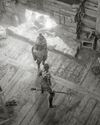The controls are exquisitely calibrated, giving you room to adjust your trajectory in mid-air.

Partway through Celeste, our mountaineer protagonist Madeline suffers a panic attack. Luckily, her occasional climbing companion, the affable Theo, has a surefire method to calm her down. Visualise a feather, he says, and breathe in and out rhythmically – imagining that each breath out is keeping it airborne. Sure enough, it rises and falls as we push a button, and before long Madeline has regained her composure. That this comes after one of the game’s most frustrating sequences doesn’t appear to be accidental. The technique, it seems, is as much for the player’s benefit as for its hero’s.
That’s because Celeste is one of those games: a pixelart platformer that constantly teeters on the edge of a precipice, the finest of margins separating compulsion and frustration. And, boy, does designer Matt Thorson know it. It’s obvious from the outset, when Madeline tells an old woman of her ambition to climb the titular peak, and the woman’s mocking laughter follows her into the next screen. It’s there, too, when Madeline smashes a mirror and a purple-haired doppelganger emerges – this is, essentially, her inner doubt, the part of her that suggests she should turn back. “Are you the weak part of me, or the lazy part?” Madeline grunts. “I’m the pragmatic part,” her grinning double replies.
This story is from the {{IssueName}} edition of {{MagazineName}}.
Start your 7-day Magzter GOLD free trial to access thousands of curated premium stories, and 9,000+ magazines and newspapers.
Already a subscriber ? Sign In
This story is from the {{IssueName}} edition of {{MagazineName}}.
Start your 7-day Magzter GOLD free trial to access thousands of curated premium stories, and 9,000+ magazines and newspapers.
Already a subscriber? Sign In

NO MORE ROOM IN HELL 2
You're not alone in the dark

WINDBLOWN
Life after Dead Cells

COLLECTED WORKS - JOSH SAWYER
Journeying to the Forgotten Realms, Infinity and beyond with the RPG veteran

SCREENBOUND
Going deep in a mind-bending hybrid of perspectives

Trigger Happy
Shoot first, ask questions later

Grand strategist
Paradox's Mattias Lilja addresses the publisher's recent difficulties - and the plan to right the ship

Diablo IV
A progress report on the games we just can't quit

Ghosts 'n Goblins Resurrection
In Capcom's diabolical tribute, evil goes far deeper than the demons on the screen

SERENITY FORGE
How a near-death experience lit a fire in the Colorado-based developer and publisher

THE MAKING OF...ALIEN: ISOLATION
How a strategy-led studio built a survival horror masterpiece in Ridley Scott's image